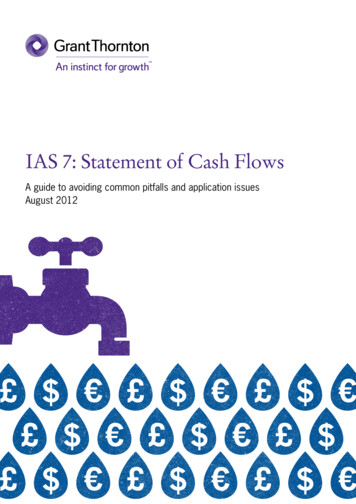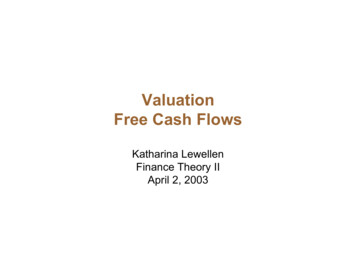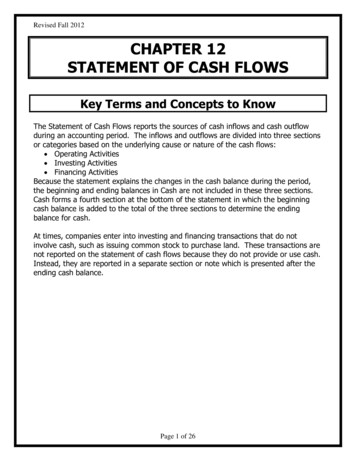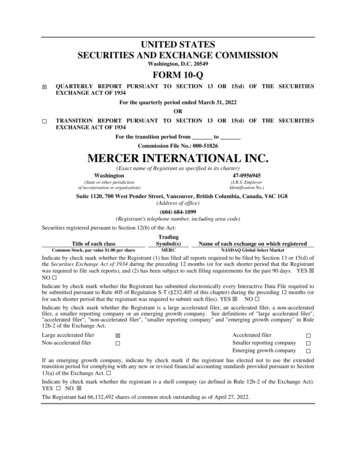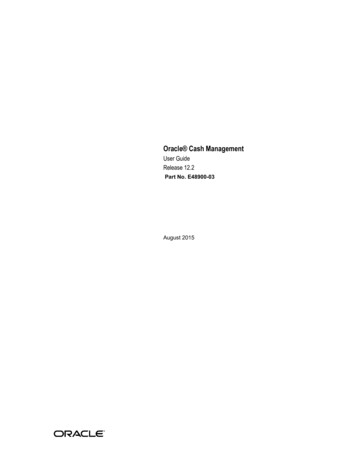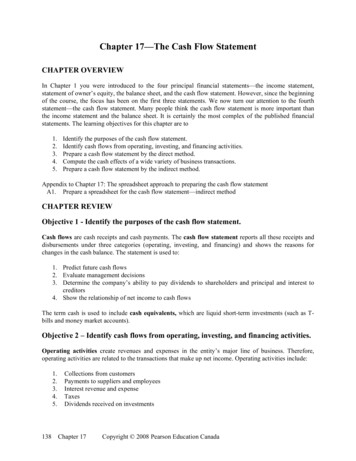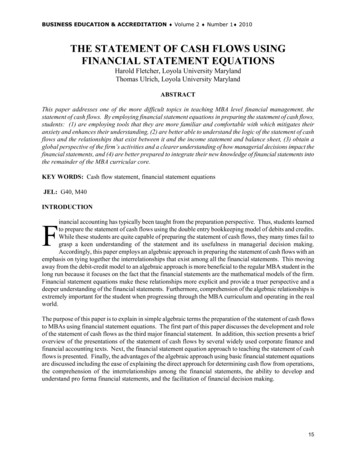
Transcription
BUSINESS EDUCATION & ACCREDITATION Volume 2 Number 1 2010THE STATEMENT OF CASH FLOWS USINGFINANCIAL STATEMENT EQUATIONSHarold Fletcher, Loyola University MarylandThomas Ulrich, Loyola University MarylandABSTRACTThis paper addresses one of the more difficult topics in teaching MBA level financial management, thestatement of cash flows. By employing financial statement equations in preparing the statement of cash flows,students: (1) are employing tools that they are more familiar and comfortable with which mitigates theiranxiety and enhances their understanding, (2) are better able to understand the logic of the statement of cashflows and the relationships that exist between it and the income statement and balance sheet, (3) obtain aglobal perspective of the firm’s activities and a clearer understanding of how managerial decisions impact thefinancial statements, and (4) are better prepared to integrate their new knowledge of financial statements intothe remainder of the MBA curricular core.KEY WORDS: Cash flow statement, financial statement equationsJEL: G40, M40INTRODUCTIONFinancial accounting has typically been taught from the preparation perspective. Thus, students learnedto prepare the statement of cash flows using the double entry bookkeeping model of debits and credits.While these students are quite capable of preparing the statement of cash flows, they many times fail tograsp a keen understanding of the statement and its usefulness in managerial decision making.Accordingly, this paper employs an algebraic approach in preparing the statement of cash flows with anemphasis on tying together the interrelationships that exist among all the financial statements. This movingaway from the debit-credit model to an algebraic approach is more beneficial to the regular MBA student in thelong run because it focuses on the fact that the financial statements are the mathematical models of the firm.Financial statement equations make these relationships more explicit and provide a truer perspective and adeeper understanding of the financial statements. Furthermore, comprehension of the algebraic relationships isextremely important for the student when progressing through the MBA curriculum and operating in the realworld.The purpose of this paper is to explain in simple algebraic terms the preparation of the statement of cash flowsto MBAs using financial statement equations. The first part of this paper discusses the development and roleof the statement of cash flows as the third major financial statement. In addition, this section presents a briefoverview of the presentations of the statement of cash flows by several widely used corporate finance andfinancial accounting texts. Next, the financial statement equation approach to teaching the statement of cashflows is presented. Finally, the advantages of the algebraic approach using basic financial statement equationsare discussed including the ease of explaining the direct approach for determining cash flow from operations,the comprehension of the interrelationships among the financial statements, the ability to develop andunderstand pro forma financial statements, and the facilitation of financial decision making.15
H. Fletcher, T. Ulrich BEA Vol. 2 No. 1 2010BACKGROUNDInvestors and creditors use financial statements to make financial decisions. These users develop anunderstanding of a firm’s sales, expenses and profitability by reviewing the income statement. They develop asense of the firm’s financial position at a particular point in time from reviewing the balance sheet. However,with only these two financial statements to review, these users do not have complete information on the extentof a firm’s operating, financing, and investing cash flow activities. For example, the cash proceeds from thedisposal of investments in property, plant and equipment or the extent of cash flows from long-term debtissuances and repayments are not disclosed in either financial statement. To overcome this problem, a thirdfinancial statement, the statement of cash flows is provided to financial statement users. The objective of thisstatement is to present information on cash provided and used from all activities of the reporting entity.Historically, cash-basis accounting preceded accrual accounting, but had limitations in measuring an entity’sincome for the period. With accrual accounting accountants were better able to match revenues and expensesyielding a more precise measure of the entity’s income for the period. However, with only a balance sheet andincome statement to review, financial managers did not have complete information with respect to the flow offunds within the entity. Thus, a funds statement was developed by financial managers as a tool to indicate, on ahistorical basis, where the funds came from and how they were used. With wide spread reporting by asignificant number of companies of the sources and uses of funds (funds statement) in annual financial reportsto shareholders and with the support of the principal stock exchanges, the Accounting Principles Board (APB)in 1963 issued Opinion No. 3, The Statement of Source and Application of Funds, which encouraged, but didnot require, the presentation of a funds statement in the annual report to shareholders. In Opinion No. 3 theAPB offered considerable latitude as to both the form and content of the funds statement, and presentationvaried widely among companies.Recognizing the increased usefulness of the funds statement to users of financial statements, the AccountingPrinciples Board in 1973 required its presentation in the annual report to shareholders by adopting APBOpinion No.19, Reporting Changes in Financial Position. In this opinion the Board sought to establishguidelines for presenting such statements including the requirement that the statement be based on a broadconcept of changes in financial position and recommended that the title of the statement be changed toStatement of Changes in Financial Position. However, under Opinion 19, the concept of funds could still bedefined broadly, primarily either as cash, working capital, or a variation on working capital. In 1987, FinancialAccounting Standards Board (FASB) solved the problem of the various definitions of funds by issuingStatement No. 95 (FASB, 1987) which replaced the statement of changes in financial position with thestatement of cash flows. In SFAS No. 95, the definition of funds was narrowed to include only cash and cashequivalents and the statement's title was changed to the statement of cash flows. The purpose of this definitionof funds was to increase comparability of corporate financial reporting and to require all companies to provideinformation on its activities on a cash basis. On the statement, cash flows are segregated by operatingactivities, investing activities, and financing activities. This statement of cash flows represents a major stepforward for users of financial statement data because of its relevance for analytical purposes. The mandatoryfocus on cash in this statement results in a more useful document than its predecessor, the statement of changesin financial position where the definition of funds was broadly interpreted across firms within the sameindustry.The statement of cash flows requires classification according to the nature of the transaction (operating,investing, or financing) as opposed to the nature of the cash receipt or payment. An objective of this statementis to assist the user in assessing the reasons for differences between net income and associated cash receiptsand payments. This is achieved by treating as operating activities all transactions that generally enter into thedetermination of net income. Another requirement of the statement of cash flows is the disclosure of noncashinvesting and financing transactions in a separate schedule. The required separate disclosure of noncash16
BUSINESS EDUCATION & ACCREDITATION Volume 2 Number 1 2010transactions maintains the all important cash focus of the statement of cash flows and distinguishes it from theless informative state of changes in financial position.The FASB Statement No. 95 allows the option of a direct or indirect method of reporting operating cash flows.The direct method reports the major classes of gross cash receipts and gross cash payments in the operatingsection of the statement, the summation of which is net cash flow from operating activities. Statements of cashflow developed on the direct basis separately classify as operating cash flows: cash received from customers;cash paid to suppliers and employees; interest and dividends received; interest paid; income taxes paid; and,other operating cash receipts and cash payments, if any. The FASB requires that a reconciliation of net incometo net cash flow from operating activities be reported in a separate supplementary schedule when using thedirect method. The indirect method of reporting operating cash flows, which is identical to the requiredsupplementary schedule in the direct method, reconciles net income to net cash flow from operations. Netincome is adjusted to remove the effects of all deferrals of past operating cash receipts and payments; allaccruals of expected future operating cash receipts and payments; and all items whose cash effects areinvesting or financing cash flows.This reporting change causes greater emphasis to be placed on cash flows, and justifies discussion of how thestatement of cash flows may be best taught to MBA students. While the level, detail and depth of coveragediffer from program to program, MBA students universally seem to struggle with this topic. Yet, it may beargued that the statement of cash flows is one of the most important accounting topics, particularly in light ofthe number of companies now faced with debt-laden balance sheets and whose solvencies are questionable dueto the economic downturn.Table 1: Overview of Leading Accounting TextsFundamental Accounting TextHarrison, Horngren & ThomasKimmel, Weygandt & KiesoDirectYesAppendixIndirectYesYesEquationsFull EquationsSimple Equations(Appendix)Needles & PowersNoYesNo EquationsPhillips, Libby & LibbyYesYesSimple EquationsThis table shows the presentation techniques of the cash flow statement in leading account dixA review of several leading corporate finance texts (Ehrhardt & Brigham, 2008; Brealy, Myers & Marcus,2009; Ross, Westerfield, & Jordan, 2010) reveals that these authors rely on students developing their moredetailed knowledge of the statement of cash flows from their prerequisite financial accounting course. Each ofthese texts primarily presents a brief description of the statement in just a few pages. Therefore, several leadingaccounting texts (Harrison, Horngren & Thomas, 2010; Kimmel, Weygandt & Kieso, 2009; Needles &Powers, 2008; Phillips, Libby, & Libby, 2008) were reviewed to determine how leading financial accountingtexts cover the statement of cash flows?Table 1 summarizes the results of the review. First, not surprisingly all of the texts cover the indirect approachto the operating section of the statement given that 99% of surveyed companies use the indirect approach intheir annual report to shareholders (AICPA, 2007). One text (Needles & Powers, 2008) does not cover thedirect method at all while another (Kimmel, Weygandt & Kieso, 2009) relegates the direct method to anappendix. The other two texts cover both methods, but for one text (Phillips, Libby & Libby, 2008) the primaryfocus is on the indirect method whiles the other text (Harrison, Horngren & Thomas, 2010) provides equalcoverage. Second, only one of the texts (Phillips, Libby & Libby, 2008) covers the worksheet approach, but itis relegated to an appendix. While the worksheet approach was quite useful in preparing the old statement ofchanges in financial position, it has lost some of its comparative advantage on the preparation side with thenew statement of cash flows. Third, all of the texts employed the T-account approach in determining the cashflows for the statement. Finally, authors are beginning to employ, on an elementary level, equations to explain17
H. Fletcher, T. Ulrich BEA Vol. 2 No. 1 2010the computation of the cash flows. When doing so, the equations are related to the T-account approach indetermining the cash flow. Only one text did not employ any equations. However, only one text, Harrison,Horngren & Thomas (2010), provides a full set of financial statement equations in their presentation by tyingthe equations to the t-accounts which they represent.FINANCIAL STATEMENT EQUATION APPROACHThe financial statement equation approach has been around for some time. Johnson (1966) analyzedalgebraically the individual changes in noncurrent accounts to provide a means to calculate directly throughequations the individual sources and uses of working capital needed for a funds statement. In addition, hepresented an algebraic system for cash-flow analysis. In this paper we begin first with the balance sheetequation and expand it to provide a logical algebraic approach for determination of cash flows. Next, thedirect approach for computing the cash flow from operations is presented using the appropriate financialstatement equations.Then, an equation for determining cash flow from operations under the indirect method is presented. Finally,financial statement equations are employed to address the cash flows from investing activities and financingactivities. Table 2 presents a listing of financial statement equations and demonstrates their algebraicmanipulation. In addition, an example, provided in Table 3, is employed throughout to illustrate the use of thefinancial statement equation approach.Table 2: Financial Statement EquationsFinancial StatementEquationsACCOUNTS RECEIVABLEA/R1 Credit Sales - Collections A/R2Collections Credit Sales - [A/R2 - A/R1]UNEARNED REVENUEUR1 Cash Advances - Revenue Earned UR2Cash Advances Revenue Earned [UR2 - UR1]INVENTORYI1 Purchases - COGS I2Purchases COGS [I2 - I1]ACCOUNTS PAYABLEA/P1 Purchases - Payments A/P2Payments Purchases - [A/P2 - A/P2]Payments COGS [I2 - I1] - [A/P2 - A/P2]PREPAID EXPENSESPE1 Prepayment – Expiration of PE PE2Prepayment Expiration of PE [PE2 - PE1]PLANT & EQUIPMENTP&E1 Acquisitions of P&E - Cost Basis of P&E Sales P&E2Acquisitions of P&E Cost Basis of P&E Sales (P&E2 - P&E1)ACCUMULATED DEPRECIATIONAD1 Depreciation Expense - AD for Asset Sales AD2Depreciation Expense AD for Asset Sales (AD2 - AD1)NOTES RECEIVABLEN/R1 Loans Made – Loans Collected N/R2Loans Collected Loans Made - [N/R2 - N/R1]Loans Made Loans Collected [N/R2 - N/R1]NOTES PAYABLEN/P1 Borrowings – Loan Repayments N/P2Borrowings Loan Repayments [N/P2 - N/P1]Loan Repayments Borrowings - [N/P2 - N/P1]WAGES PAYABLEW/P1 Wages Expense - Wages Paid W/P2Wages Paid Wages Expense - [W/P2 - W/P1]ACCRUED LIABILITIESA/L1 Accrued Expense – Payment of Accruals A/L2Payment of Accruals Accrued Expense -[A/L2 - A/L1]18
BUSINESS EDUCATION & ACCREDITATION Volume 2 Number 1 2010Financial StatementEquationsINTEREST PAYABLEI/P1 Interest Expense - Interest Payment I/P2Interest Payment Interest Expense - [I/P2 – I/P1]DEFERRED INCOME TAXDIT1 Income Tax Expense – Income Tax Payment DIT2Income Tax Payment Income Tax Expense - [DIT2 -DIT1]CAPITAL STOCKCS1 Issuance - Redemption CS2Issuance Redemption [CS2 - CS1]DIVIDENDS PAYABLED/P1 Dividends Declared – Dividends Paid D/P2Dividends Paid Dividends Declared - (D/P2 – D/P1)RETAINED EARNINGSRE1 NI – Dividends Declared RE2(RE2 – RE1) NI – Dividends DeclaredThis table shows the key financial statement equationsSince our goal is not only to have the student prepare the statement of cash flows but also to be able to use it indecision making, we introduce the student to the concept of sources and uses of funds. The sources and uses offunds statement, a precursor of the statement of cash flows, has been one of the most useful tools for thefinancial manager as it indicates where, on a historical basis, cash came from and where it was used. When afirm applies for a loan, one of the first questions posed by the loan officer is what has your firm done with themoney it had? This is usually followed by when and how is your firm going to repay the loan? The ability ofthe sources and uses statement to answer these questions and its early use attest to its managerial usefulness.Each change in the balance sheet may be classified as either a source or a use of funds. A use of funds is anincrease in an asset or a decrease in a liability or equity. A source is a decrease in an asset or an increase in aliability or equity. As indicated in Table 3, the student can easily identify the changes in the balance sheetsaccounts as either a source or a use. As a check, the sums of sources and uses are equal if the student correctlyanalyzed the balance sheet account changes. Given the concept of sources and uses of funds, we direct thestudent to the balance sheet equation and expand it to provide an equation for computing the cash flows.In the equations below, A assets, L liabilities, E equities, OA other assets, CC contributed capital,RE retained earnings, CL current liabilities, LTL long-term liabilities, OCA current assets other thancash, LTA long-term assets, NI net income, and D dividends.A L ECash OA L ECash L E - OASubstituting into the above equation E CC RE; OA OCA LTA; and L CL LTL yields thefollowing.Cash CL LTL CC RE - OCA - LTA.Since the focus of the statement of cash flows is on flows or changes in cash, we modify our equation to reflectthe changes in the balance sheet accounts.ΔCash ΔCL ΔLTL ΔCC ΔRE - ΔOCA - ΔLTASubstituting into the above equation ΔRE NI - D yieldsΔCash ΔCL ΔLTL ΔCC NI - D - ΔOCA - ΔLTA19
H. Fletcher, T. Ulrich BEA Vol. 2 No. 1 2010And, then rearranging we have the following.ΔCash NI ΔCL - ΔOCA - ΔLTA ΔLTL ΔCC - DThis derivation of the cash flow equation from the balance sheet equation clearly illustrates that cash flows aredetermined by changes in the balance sheet accounts.The Direct Method for Cash Flow from OperationsOperating activities make up the first section of the statement of cash flows, and it can be presented usingeither of two methods. The direct method presents the gross operating cash flows for the period. The use offinancial statement equations makes the logic of this approach apparent. The cash received from customers isderived from the accounts receivable equation,A/R1 Credit Sales - Collections A/R2,Which is rearranged to solve for the cash flow (collections),Collections Credit Sales - [A/R2 - A/R1].For Carson Products, the collections would equal 460,000 500,000 – [ 120,000 - 80,000].To determine the cash paid for the cost of merchandise purchased requires the use of two equations: the inventoryequation and the accounts payable equation.I1 Purchases - COGS I2A/P1 Purchases - Payments A/P2First, the inventory equation is solved for purchases,Purchases COGS [I2 - I1].Next, the accounts payable equation is solved for payments,Payments Purchases - [A/P2 - A/P2].Then, the purchases equation is substituted into the payments equation to yield,Payments COGS [I2 - I1] - [A/P2 - A/P2].For Carson, therefore, payments for the cash paid for merchandise is equal to 287,000 300,000 [ 140,000 – 90,000] – [ 123,000 – 60,000].20
BUSINESS EDUCATION & ACCREDITATION Volume 2 Number 1 2010Table 3: Carson ProductsJonathan Carson, president of Carson Products, considers 16,000 to be the minimum cash balance for operating purposes. However, at the end of 2007Carson Products has a cash balance of only 8,000. As the company reported higher net income for the year, and issued both bonds and common stock,the decline in cash was a mystery to Jonathan.The following additional information is available for the year 2007:a. Dividends totaling 9,000 were declared and paid.b. Equipment was sold during the year at a selling price of 8,000. The equipment had a cost of 20,000 and had accumulated depreciation of 10,000.c. Preferred Stock was converted into an equal amount of common stock.d. Long-term investments that had a cost of 20,000 were sold during the year for 30,000.Required:1. Prepare a statement of cash flows for 2007 using the indirect method.2. Since the Cash account decreased so dramatically during 2007, the company’s other executives as well as Mr. Carson were interested in seeing thestatement of cash flows prepared using the direct method as well.AssetsCurrent assetsCashAccounts receivable, netInventoryPrepaid expensesTotal current assetsLong-term investmentsPlant and equipmentLess: accumulated depreciationNet plant and equipmentTotal assetsLiabilities and Stockholders’ EquityCurrent liabilities:Accounts payableAccrued liabilitiesTotal current liabilitiesBonds payableDeferred income taxesTotal liabilitiesStockholders’ equity:Preferred stockCommon stockRetained earningsTotal stockholders’ equityTotal liabilities and stockholders’ equitySalesLess cost of goods soldGross marginLess operating expensesNet operating incomeNonoperating items:Gain on sale of investmentsLoss on sale of equipmentIncome before taxesLess income taxesNet incomeCARSON PRODUCTSComparative Balance SheetDecember 31, 2007, and 200620072006 0)370,000 693,000 )250,000 520,000 123,0008,000131,00070,00020,000221,000 60,00017,00077,00080,000286,000106,000472,000 693,00096,000250,00085,000431,000 ,000245,00016,000245,000CARSON PRODUCTSIncome StatementFor the year December 31, 2007 500,000(300,000)200,000(158,000)42,000 10,0002,0008,00050,000(20,000) 30,000This table presents the Carson Products application of the development of the cash flow statementCash payments for income taxes is computed using the following equation,21
H. Fletcher, T. Ulrich BEA Vol. 2 No. 1 2010DIT1 Income Tax Expense – Income Tax Payment DIT2where DIT stands for deferred income tax. Solving for income tax payment yieldsIncome Tax Payment Income Tax Expense - [DIT2 -DIT1].For Carson this equals 12,000 20,000 – [ 20,000 – 12,000].Finally, before we can compute the cash outflow for operating expenses, we must reduce the amount of operatingexpenses on the income statement for the amount of depreciation expense, which does not represent a cashoutflow ( 20,000). The computation for depreciation expense is shown below. Here, two equations are required,the equation for prepaid expenses and the equation for accrued liabilities, as both have terms representingpayments for operating expenses.PE1 Prepayment – Expiration of PE PE2A/L1 Accrued Expense – Payment of Accruals A/L2Both of these equations are solved for their respective cash flows.Prepayment Expiration of PE [PE2 - PE1]Payment of Accruals Accrued Expense – [A/L2 - A/L1]The sum of Expiration of PE and Accrued Expense equals the operating expenses requiring a cash outlay,which is equal to the operating expenses on the income statement less depreciation expense or 138,000[Operating expenses less depreciation 158,000 - 20,000]. Thus, we can combine these two equations bysumming the payments for operating expenses to equal the cash outflow for operating expenses.Cash outflow for operating expenses Operating Expense – Depreciation [PE2 – PE1] – [A/L2 - A/L1].For Carson this equals: 143,000 [ 158,000 - 20,000] [ 5,000 - 9,000] – [ 8,000 - 17,000].The overall result is the cash flows from operations for Carson computed using the direct method in Table 4.Table 4: Carson Products Statement of Cash Flows (Direct Method) For the Year ended December 31, 2007Operating activities:Cash received from customersLess cash disbursements for:Cost of merchandise purchased 287,000Operating expenses143,000Income taxes12,000Total cash disbursementsNet cash flow from operating activitiesThis table presents the Carson statement of cash flows using the direct method.22 460,000442,000 18,000
BUSINESS EDUCATION & ACCREDITATION Volume 2 Number 1 2010The Indirect Method for Cash Flow from OperationsRecognizing that the FASB defines cash flows from operating activities as the cash effects of all transactionsand events that enter into the determination of net income, an equation reconciling net income to cash flowfrom operations is presented incorporating the concept of sources and uses of funds. Rather than trying toremember whether one adds the decrease or subtracts the increase in the balance sheet account or vice-versa,the reconciliation equation adjusts net income for the noncash charge of depreciation, adds the sources,subtracts the uses, adds back the nonoperating losses (NOL), and subtracts the nonoperating gains (NOG).CFO NI Depreciation Sources - Uses NOL - NOGThe sources, among the operating assets and operating liabilities, for Carson Products are as follows: decreasein prepaid expenses ( 4,000), increase in accounts payable ( 63,000), and increase in deferred income taxes( 8,000). The uses, among the operating assets and operating liabilities, for Carson Products are: increase inaccounts receivable, net ( 40,000), increase in inventory ( 50,000), and decrease in accrued liabilities( 9,000). There is a nonoperating loss of 2,000 from the sale of equipment that had a cost of 20,000,accumulated depreciation of 10,000, and a book value of 10,000 that was sold for 8,000. There is anonoperating gain of 10,000 from selling long-term investments that had a cost of 20,000 for 30,000. Thisleads to cash flow from operations of 18,000, as shown in the following summary calculation. Also, seeTable 5, which illustrates the indirect method for calculating cash provided from operations.CFO NI Depreciation Sources - Uses NOL - NOGCFO 30,000 20,000 4,000 63,000 8,000 - 40,000 - 50,000 - 9,000 2,000 - 10,000 18,000Cash Flows from Investing and Financing ActivitiesThe cash inflow from investing activities for Carson products equals the selling prices for the long-terminvestments ( 30,000) and equipment ( 8,000). The cash outflow for the purchase of plant and equipment canbe determined using the following equation:P&E1 Acquisitions of P&E - Cost Basis of P&E Sales P&E2.Solving for the cash flow, in this case, Acquisitions of P&E yieldsAcquisitions of P&E Cost Basis of P&E Sales (P&E2 - P&E1) 20,000 ( 430,000 - 300,000) 150,000.Refer to Table 5. Since the depreciation expense was not listed separately in the income statement, it must becomputed from the following accumulated depreciation equation,AD1 Depreciation Expense - AD for Asset Sales AD2.Solving this equation for depreciation yieldsDepreciation Expense AD for Asset Sales (AD2 - AD1).For Carson depreciation expense is 20,000 10,000 ( 60,000 - 50,000).The cash inflow from financing activities for Carson Products equals the sale of bonds ( 70,000) and the saleof common stock ( 20,000). Note that while the change in the common stock account of 36,000 is listed as a23
H. Fletcher, T. Ulrich BEA Vol. 2 No. 1 2010source of 36,000, it must be adjusted for the use of 16,000 from the decrease in preferred stock resulting fromthe conversion of preferred stock into common stock. Since the conversion of the preferred into common didnot require the use of cash, this transaction would not appear on the statement of cash flows. However, it is animportant financing decision and is, therefore, reported in a supplemental schedule below the statement of cashflows. Thus, the cash flow from issuing common stock is equal to 20,000 ( 36,000 – 16,000) and there wasno cash flow generated from the decrease in preferred stock. The accounting equation for retained earnings isRE1 NI – Dividends Declared RE2. The source column in Table 3 shows a source for retained earnings of21,000. However, that difference shows up on the cash flow statement not in this net amount but as a source of30,000 (net income) and a use of 9,000 (dividends paid), which equals a net source of 21,000 (see Table 5.)Table 5: Carson Products Statement of Cash Flows (Indirect Method) For the Year ended December 31, 2007Operating activities:Net incomeAdjustments needed to convert net income to a cash basis:Depreciation expenseAdd sources:Decrease in prepaid expensesIncrease in accounts payableIncrease in deferred taxesSubtract uses:Increase in accounts receivableIncrease in inventoryDecrease in accrued liabilitiesNonoperating gains and losses:Gain on sale of investmentsLoss on sale of equipmentNet cash flow from operating activitiesInvesting activities:Cash was provided by:Sale of investmentsSale of equipmentCash was used for:Purchase plant and equipmentNet cash flow from investing activitiesFinancing activities:Cash was provided by:Issuance of bondsSale of common stockCash was used for:Payment of dividendsNet cash flow from financing activitiesNet change in cashSupplemental schedule of noncash investing and financing activities:Preferred stock converted into common stockThis table presents the Carson statement of cash flows using the indirect method. 30,00020,000 4,00063,0008,00075,000( 40,000)(50,000)(9,000)(99,000)(10,000)2,000 18,000 30,0008,000(150,000)( 112,000) 70,00020,000(9,000) 81,000( 13,000) 16,000CONCLUSIONOne of the most difficult topics for students to master in the initial MBA financial management course is thestatement of cash flows. The goal of this paper is to present an alternative technique for student instruction inthe creation of the cash flow statement based on
The purpose of this paper is to explain in simple algebraic terms the preparation of the statement of cash flows to MBAs using financial statement equations. The first part of this paper discusses the development and role of the statement of cash flows as the third major financial statement .


